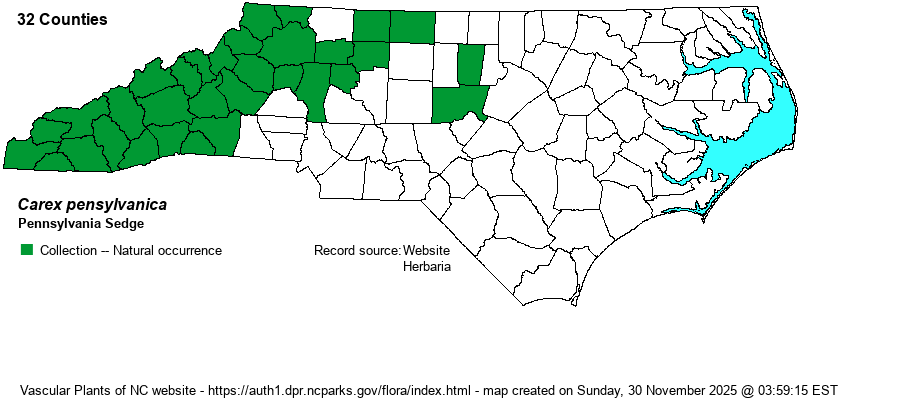| Author | Lamarck | |
| Distribution | This account and our map are no longer valid. Recent research by Derick Poindexter has proven that this species, as traditionally understood, does not occur in NC. Weakley et al. (2024), in fact, omits it from NC. Taxon Editors will retain this species account merely for historical reasons.
ME to Man. and ND, and south to SC, TN, and AR. | |
| Abundance | Common to often locally abundant in the Mountains; common in the northwestern Piedmont, but scarce in the central portions. | |
| Habitat | A great variety of upland forests, mesic to rather dry; grassy balds, outcrops, and other fairly dry places. | |
| Phenology | Flowers and fruits April - June. | |
| Identification | This is a very familiar plant of upland forests in the mountains, such as carpeting the ground under various northern hardwoods and beech gap forests. Grows in clumps, with long rhizomes; narrow leaves are 1-3 mm wide, and fruiting stalks grow to 8-12 inches tall. There are 2-3 female spikes, each narrow and only about 5-10 mm long. It is quite similar to C. austroleucorum, which see; it also occurs in the mountains. | |
| Taxonomic Comments | The taxonomic status of this species in NC and adjacent states in being studied at the moment by Derick Poindexter at UNC Chapel Hill.
The genus Carex is the largest in North America, and among the largest in the world. In temperate and boreal regions, Carex is often the dominant or co-dominant ground layer in many habitats. Seeds (achenes) are valuable food for birds and small mammals, while foliage is used by birds and mammals to make nests and as food by mammals. Species of Carex often look vastly different from one another -- spikes erect vs. drooping, tiny inflorescence vs. whopping, culms leafy vs. naked, perigynia beaked vs. beakless, stems densely bunched vs. single, etc. The genus has been divided into many sections (or groups), based on shared characters; some taxonomists have suggested that these be different genera, but that proves unworkable (so far). All Carex share the feature of a perigynium (an outer covering) which completely surrounds the achene (seed). This covering may fit tightly or loosely (like a small bladder), depending on which group or species. Details of perigynia shape, ornamentation, presence and size of beak, number of striations (or veins) are all important ID features. In recent years Rob Naczi and colleagues have stressed the importance of arrangement of perigynia -- whether spiral (3+ ranks) or distichous (2-ranked) -- and have named a number of new species as well as split off some older synonyms. Therefore, RAB's (1968) key, excellent for its time, can only be used in a general way today. Members of some sections of Carex are difficult to key out (notably Ovales, Laxiflorae, Griseae); this is in part due to variation among individuals of a species, or failings of the key. FNA has drawings of most species and some species may be found in two or more places within a key, to acount for variability. New species to NC, and new to science(!), continue to be found in NC. | |
| Other Common Name(s) | None | |
| State Rank | S5 | |
| Global Rank | G5 | |
| State Status | | |
| US Status | | |
| USACE-agcp | | |
| USACE-emp | | |

